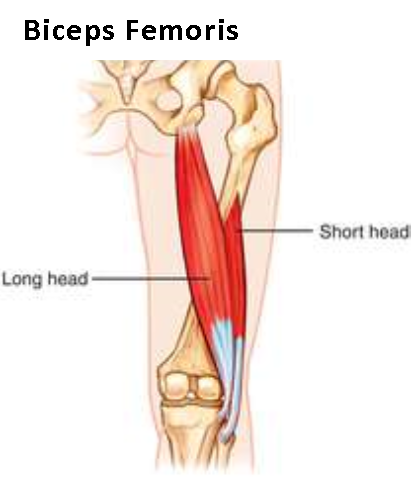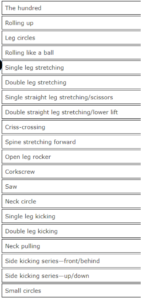Excerpts from the study
Najmeh Noghani, Rahman Sheikhhoseini & Farideh Babakhani
Published online: 07 Sep 2022 : https://www.researchgate.net/publication/363360474_Pilates_Exercises_Improves_Anticipatory_Muscular_Activation_in_Elderly_Women_A_RCT_Study
Summary of abstract:
Aims: to investigate the effects of Pilates exercise on the anticipatory activation of selected lower limb muscles and balance in elderly women who had previous history of falling.
Methods: A randomized clinical trial study with 22 elderly women with 10 in the control and 12 in the experimental group. The experimental group performed the Pilates exercises for eight weeks (three sessions of one hour per week).
Results: Pilates exercises had a significant effect on the Berg balance scale, the timed up and go test, the onset time of the tibialis anterior, vastus lateralis, vastus medialis, and biceps femoris.
Conclusion: Pilates exercises can improve anticipatory activation of lower extremity muscles, balance and performance in elderly women with falling history. In older women, participating in Pilates exercises can shorten the onset time and lower the co-activation ratio. Pilates exercises are recommended for the training and rehabilitation of elderly people who have a history of falling.


image sources: https://en.wikipedia.org/wiki/Vastus_lateralis_muscle. https://mobilephysiotherapyclinic.in/biceps-muscle-details/
Selected quotes from the study
Existing evidence suggests that using Pilates …… improves flexibility and dynamic balance,1 and in general, Pilates has been suggested to improve independence, static balance, and quality of life in the elderly.2 Recently, another study found that Pilates may have a greater effect than a general physical activity on physical performance in elderly population.3
It has been demonstrated that anticipatory muscular adjustments for postural control differ significantly between the elderly and the young and between the elderly with and the elderly without a history of falls.4 Antagonist muscles are activated nearly simultaneously with agonist muscles in the elderly (co-contraction). This muscle co-activation can lead to a loss of balance.5,6 On the other hand, Pilates exercises have been shown to prevent involuntary body movements by using resources such as gravity and the resistance of springs, either to resist or assist movement execution.7
Classes in the first week
All of the traditional Pilates method recommendations were followed: centralization, concentration, control, precision, breathing, and flow.


Classes in the next ten weeks of intervention

Discussion
This exercise program ….improved activity onset time (predictive anticipatory function of the tibialis anterior, vastus lateralis, vastus medialis, and biceps femoris).
According to the current study, exercise affects anticipatory postural adjustments, which may reflect changes in the central nervous system and improve muscle function by improving proprioception and neuromuscular coordination.8 Improved anticipatory movement in the central nervous system may have altered muscle activation patterns, motor control, and postural muscle latency.9,10
However, while co-contraction may be a compensatory strategy, high co-contraction levels in the elderly may increase energy expenditure, decrease efficiency during movement, increase mechanical work, increase metabolism, and increase motor units to control postural causes slow movement.11 Furthermore, chronic co-contraction may result in increased joint compression forces and the progression of osteoarthritis.12 Although co-contraction improves joint stability while standing, it impairs dynamic postural control.13 Previous research has found that ….the elderly have more co-contraction in the knee joint, ankle, and ankle stabilizer.
In healthy older persons, the six-week intervention was sufficient to improve gait patterns.
References
- Cruz-Ferreira A, Fernandes J, Laranjo L, Bernardo LM, Silva A. A systematic review of the effects of pilates method of exercise in healthy people. Arch Phys Med Rehabil. 2011;92(12):2071–2081. doi:10.1016/j.apmr.2011.06.018
- Siqueira Rodrigues BG, Ali Cader S, Bento Torres NV, Oliveira EM, Martin Dantas EH. Pilates method in personal autonomy, static balance and quality of life of elderly females. J Bodyw Mov Ther. 2010;14(2):195–202. doi:10.1016/j.jbmt.2009.12.005.
- Patti A, Zangla D, Sahin FN, et al. Physical exercise and prevention of falls. Effects of a Pilates training method compared with a general physical activity program: a randomized controlled trial. Medicine (Baltimore). 2021;100(13):e25289. doi:10.1097/md.0000000000025289.
- Claudino R, dos Santos EC, Santos MJ. Compensatory but not anticipatory adjustments are altered in older adults during lateral postural perturbations. Clin Neurophysiol. 2013;124(8):1628–1637. doi:10.1016/j.clinph.2013.02.111.
- Bounyong S, Adachi S, Ozawa J, et al. Fall risk estimation based on co-contraction of lower limb during walking. 2016 IEEE International Conference on Consumer Electronics (ICCE), 2016, pp. 331–332, doi: 10.1109/ICCE.2016.7430634
- Iwamoto Y, Takahashi M, Shinkoda K. Muscle co-contraction in elderly people change due to postural stability during single-leg standing. J Physiol Anthropol. 2017;36(1):43. doi:10.1186/s40101-017-0159-1.
- Siqueira Rodrigues BG, Ali Cader S, Bento Torres NV, Oliveira EM, Martin Dantas Pilates method in personal autonomy, static balance and quality of life of elderly females. J Bodyw Mov Ther. 2010;14(2):195–202. doi:10.1016/j.jbmt.2009.12.005.
- Aman JE, Elangovan N, Yeh IL, Konczak J. The effectiveness of proprioceptive training for improving motor function: a systematic review. Front Hum Neurosci. 2014;8:1075. doi:10.3389/fnhum.2014.01075
- Knox MF, Chipchase LS, Schabrun SM, Marshall PWM. Improved compensatory postural adjustments of the deep abdominals following exercise in people with chronic low back pain. J Electromyogr Kinesiol. 2017;37:117–124. 10.1016/j.jelekin.2017.10.009.
- Curuk E, Lee Y, Aruin AS. Individuals with stroke improve anticipatory postural adjustments after a single session of targeted exercises. Hum Mov Sci. 2020;69:102559. doi:10.1016/j.humov.2019.102559
- Gabriel DA, Kamen G, Frost G. Neural adaptations to resistive exercise: mechanisms and recommendations for training practices. Sports Med. 2006;36(2):133–149. doi:10.2165/00007256-200636020-00004.
- Mian OS, Thom JM, Ardigò LP, Narici MV, Minetti AE. Metabolic cost, mechanical work, and efficiency during walking in young and older men. Acta Physiol. 2006;186(2):127–139. doi:10.1111/j.1748-1716.2006.01522.x.
- Tsai LC, McLean S, Colletti PM, Powers CM. Greater muscle co-contraction results in increased tibiofemoral compressive forces in females who have undergone anterior cruciate ligament reconstruction. J Orthop Res. 2012;30(12):2007–2014. doi:10.1002/jor.22176.

Comments are closed.